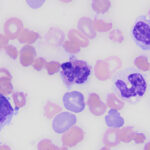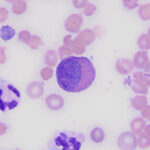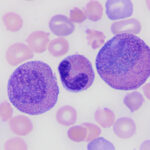Venous blood smear from a Hedgehog
Case Information
A 3.5 year-old, intact male hedgehog presented to Cornell University Hospital for Animals Emergency Service for inappetence, lethargy, and ataxia. The owner had been away for 7 days and left the animal with enough food and water to last the week. Upon return, the owner noticed that the hedgehog had only consumed about 25% of the food and water. Upon presentation, the patient weighed 304 grams (expected weight, 400-600 grams), had pale mucous membranes and was mildly tachypneic (54 breaths/minute; expected normal, 25-50 breaths/minute). The animal had a normal heart rate of 240 beats/minute (expected normal, 180-280 beats/minute) and temperature (96°F, expected normal, 96-99°F).1 The patient was anesthetized for collection of blood for a complete blood count (CBC) and biochemical panel as well as whole body radiographs.
The CBC revealed that the animal was anemic (hematocrit, 23%, reference interval [RI], 36-47%2) and had a marked leukocytosis (109.1 x 103/μL, RI, 11.5-21.7 x 103/μL2). The automated platelet count was 277 x 103/μL (no available RI). Biochemical testing revealed a mildly increased creatinine concentration (1.5 mg/dL, RI, 0.5-1.0 mg.dL2) with normal urea nitrogen concentration (52 mg/dL, RI, 34-57 mg/dL2), and increased liver enzyme activities (alanine aminotransferase [ALT], 269 U/L, RI, 15-29 U/L2, alkaline phosphatase [ALP], 2820 U/L, RI, 18-26 U/L2) and hyperbilirubinemia (3.2 mg/dL, ISIS mean ± SD, 0.5 ± 0.1 mg/dL, Physiological Data Reference Values, International Species Information System, 1996). Representative images of the blood smear are shown (Figures 1-4).
After viewing the images, answer the posed questions:
- What is the lineage of most of the cells represented in the images?
- What are your differential diagnoses?
- What additional testing can be done to help clarify cell lineages in this species?
Answers on next page




